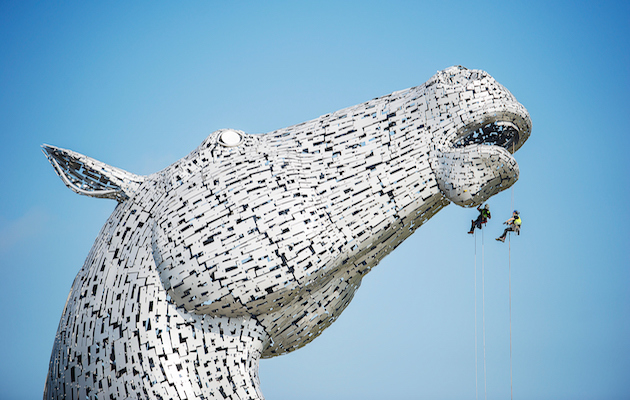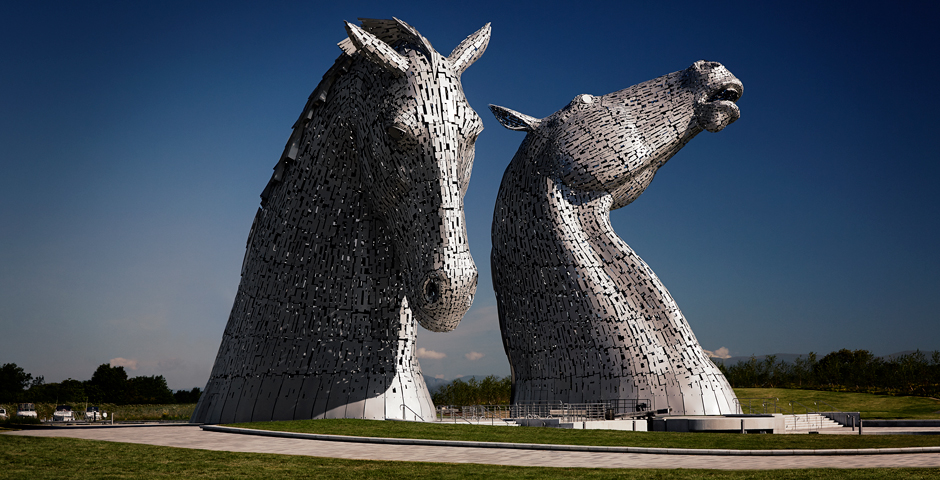The Kelpies, the world’s largest pair of equine sculptures, are having their first “health check” since they were unveiled in 2014. Read the story here.
The Kelpies, Andy Scott’s most famous work, are made of stainless steel. They stand approximately 100 feet tall and weigh 300 tons. The two horses straddle a canal in Falkirk, Scotland, where the great, heavy horses would have once pulled barges and plowed the surrounding fields.
EQLiving was curious to learn more about Scott’s vision and how these massive works were created, so we invited Andy and his wife, Hanneke, to EQLiving’s New York City office and he spoke with EQ editors about his work.
Scott’s enthusiasm for his art was contagious, and we were captivated by his charming anecdotes, his obvious mastery of the craft, and of course his lilting Scottish accent.
His relationship with horses is not that of rider or horse owner, yet horses have become what he calls his artistic obsession. Scott recently discovered some old family photos that reveal his familial ties to horses. His great-grandfather worked with horses on a farm near Glasgow, and his great- uncle was a farrier. “It wasn’t something I was very aware of, to be honest,” he said. For Scott, it served as an example of the way horses are woven into the fabric of Scottish history, relating to the lives of everyone in some small way.
Equestrian Inspiration
The seeds of his equestrian inspiration were planted with a project called Heavy Horses, which has become one of the most recognized sculptures in Scotland. After the success of that work, he was invited to create another, and another, until the theme had developed into a genuine interest for him.

photo: Peter Sandground
His recent triumph, the Kelpies, are a pair of 100-foot-tall horse head statues along the highway in Falkirk, Scotland. Named for the Scottish mythological water horses, the statues were built on an area of wetlands along the Forth and Clyde Canal, where the Helix land transformation project has improved the connections between and around the surrounding communities. Despite the ethereal name, Scott said he intended to bring the equestrian idea to life in a much more concrete way. “Glasgow is an industrial city, and I didn’t feel that something abstract was appropriate there,” he said. “I’m much more interested in the working horses, those that worked in that area, that drove the Industrial Revolution in Scotland. I pulled away from the mythological toward the real horses to whom we owe so much.”
SEE TIME-LAPSE VIDEO OF THE KELPIES BEING BUILT.
A Challenging Charge
Scott described the massive work as “daunting.” He knew what some of the challenges might be, and knew there would be many more that he could not anticipate. His lofty visions for the statue added time and cost to the project, a price he, at first, had a difficult time explaining to the engineers and financiers. “The turning point came when I built the tenth-scale maquettes,” he said. “It would have been quite simple and inexpensive to build two identical horse heads, but I wanted to create a tension between them, to give them energy.” The team of engineers had to conduct many tests in order to ensure the balance of the complex structure in the face of Scotland’s extreme weather.
Another daunting aspect of the project was the debate it created as to the relevance and responsibility of public art. “You have to have broad shoulders to create public art, especially when it’s 100 feet tall,” laughed Scott. “Some folks would have it be more abstract and more difficult to understand. The Kelpies are very accessible. Everyone can recognize them right off. There have been some critiques that they’re too bland or too obvious, but it’s not an art gallery. I’ve made it for the widest audience possible.”
During the project, Scotland experienced the worst recession in living memory. “Try telling the local population while everyone is losing their jobs that we’re building steel horses 100 feet high,” he said. “But we did it and the local public was right behind us.” Today, the Kelpies stand as a point of pride for the local population and for the country as a whole. Tourists from around the globe come to enjoy the unique and magical experience of witnessing their massive scale.
The Road Ahead
Scott is currently opening a studio in Philadelphia. He also recently completed work on a statue of a Friesian for the Netherlands. Scott smiled as he emphasized the Dutch people’s pride in the Friesian breed and his trepidation as a Scotsman to be asked to create a steel representation of the revered horse. “They had one of the top judges of the breed in the country come to critique my work,” he recalled. “Fortunately, I passed the test. He had only a few subtle tweaks to the muscles and so on. I was thrilled.”
Though his public work is often the focus of national pride, Scott hopes to pursue more privately commissioned pieces, especially in the U.S. As recognition of his name grows, more people have contacted him to request a custom statue, to ask him for replicas of ones they have seen, or to simply tell him they enjoy his work.
It’s obvious that he is proud of his work, not for its positive reception by art critiques or its monetary success, but for the meaning it has for the people who enjoy it. He speaks of his incredible accomplishments with a humility and enthusiasm that leads one to believe he is thrilled with the opportunities he has had.
“One time the phone rang,” he remembered, “and it was a chap in Ireland, who said ‘I was just looking at your statue, and I just thought I would phone you and tell you you did a grand job.’” He paused, beaming with pride.
“Isn’t that nice that he would make the effort to let me know that?”
Meet Andy Scott and learn the story of these monumental sculptures here.

